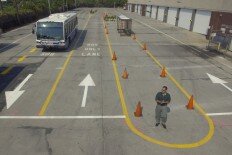STA Newsletter
Issue # May 2018
A bi-monthly online journal providing news and background about activities undertaken by STA with a view to improving the methods, technologies and standards associated to transportation infrastructures.
STA Technical Committee on Smart Safety and Security, TC2, launches an open survey on the challenges and opportunities associated to safer and more secure networks
31 May 2018
The STA Technical Committee on Smart Safety and Security, TC2, chaired by Mr Wolf Peter Zeplin, has launched a survey to assess the opinion of our readers on the challenges and opportunities faced by a new generation of safer and more secure transportation infrastructures.
The survey explores perceptions about:
Infrastructure safety, understood as the prevention of accidents (accidents which may or may not involve human agents, but are in any case not intentional), and
Infrastructure security, understood as the prevention of malicious activities by people (mugging, burglary, robbery, terrorist activities, etc.).
The data collected from this short survey will allow STA to assess the importance of several factors when it comes to the deployment and management of the Smart Transportation Infrastructures of the Future.
Please contribute to the survey (5’) clicking here.
frontierCities2 launches survey to map Smart Cities needs
17 May 2018
The frontierCities2 project has launched a ‘City Needs Mapping’ survey specifically aimed at Cities to explore the possibility of establishing fruitful links between cities and innovative start-ups deploying FIWARE– based solutions.
The objective of this survey is twofold. Firstly, to identify the main challenges and opportunities affecting cities nowadays, and secondly, to investigate the general orientation of cities towards 'Smart Cities' strategies.
Please note that this survey is aimed exclusively at cities and their representatives. The survey is accessible here.
“Supplying society with a more secure network of Smart transportation infrastructures will decrease their degree of vulnerability to natural and man-made disasters.”
NEWS OF INTEREST
Transport Ministers vow to keep travellers and freight safe and secure
Ministers with responsibility for transport from the 59 member countries of the International Transport Forum have underlined the critical importance of keeping transport safe, secure and resilient in order to enable societies and economies to prosper.
“Safety and security are of fundamental concern for transport, both as the basis of a citizen’s right to travel without fear, and as a condition for the reliable and efficient transport of goods”, Ministers state in a joint declaration agreed unanimously at their Annual Summit on 24 May in Leipzig, Germany.
A tale of two technologies
The Missouri Department of Transportation (MoDOT) executed a year-long project throughout 2017 to demonstrate the use of intelligent compaction (IC), infrared scanning (IR) and Veta software to improve pavement construction operations.
“We were looking for ways to assess quality in asphalt projects,” said Bill Stone, research administrator at MoDOT. “We are working towards better pavements that last longer, and assessing the placement and monitoring of those pavements. We felt IC and IR could benefit us.”
Joining the dots: four ways to help cities make the connection
Smoothing the path to connected transportation systems in urban areas all round the world takes a lot of planning: Cisco’s Kyle Connor lays out the four key areas on which he thinks cities should focus.
When is a Dedicated Bus Lane Not a Dedicated Bus Lane?
Why are trains usually more reliable than buses? Mostly because they don’t have to mix with other vehicles. Dedicated rights-of-way—in this case, tracks—help trains move quickly and evenly; they’re not constantly dragged down by car traffic like their rubber-tired counterparts.






